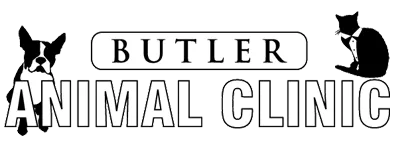It’s that time of year again! We have all made our New Year’s resolutions and hopefully we haven’t broken any of them yet. For most of us, losing weight and getting healthy is written somewhere on that list, but what about your pets? Have you ever thought of making resolutions for them too? Statistics tell us that we should be including our furry family members in on the fitness plan. In America, 42% of dogs and 44% of cats between the ages of 5 and 11 are overweight.
Sure some of us think it’s cute to have a squishy cat or few extra rolls on that Pug, but the health risks are the same for overweight and obese animals as they are for humans. Obesity can cause or exacerbate diseases such as Diabetes, Cushing’s disease, thyroid disease, heat stroke, arthritis, kidney disease, heart disease, skin infections, urinary tract diseases, and cancer. Studies have also shown that even being moderately overweight for the majority of a pet’s life can decrease their life span by an average of 2 years! So how do we define obesity in animals? If their current weight is more than their ideal weight + 20%, then they are obese. For example, a typical house cat that should weigh about 10 lbs becomes obese when their weight exceeds 12 lbs and for a dog that has an ideal weight of 50 lbs, they are considered obese when their weight exceeds 60 lbs! The window for health and ideal weight is much smaller in animals than in people because of their lower weights and smaller size.
So what’s making them fat and how do we fix it? First, we should address any health issues that may be causing weight gain or making weight loss more difficult. This would start with a thorough physical exam and assessment of any past medical issues, medications that are being given, and current bloodwork and endocrine testing. Next, we need to address the feeding plan. It is important to feed pets based on their ideal weight and to remember that anything additional (i.e. treats and table food) all count as extra calories and should be calculated into the diet, but ideally, eliminated completely. Giving a 20 lb dog just 1 ounce of cheddar cheese is the equivalent of an average person eating 1 ½ hamburgers and giving that to a 10 lb cat is like that same person eating 2 ½ hamburgers! Little snacks add up in a big way! But don’t worry, once we figure out what your pet’s ideal weight is we can calculate the appropriate calorie intake per day to help achieve that weight loss. Third, we have to increase exercise. I know this can be difficult if not impossible in cats. Some methods people have tried are to increase play time with toys they can chase and laser pointers. Dogs need a good old-fashioned walk. The increased activity will burn more calories and drop the weight faster, but is also great for every aspect of health from heart and respiratory health to bone and joint health. When implementing a new exercise routine don’t push for too much too fast. An obese dog will not suddenly be able to run for miles. Begin with short walks and increase with time, but always monitor your dog for excessive panting, limping, or tiredness. Obese dogs do not cool themselves off as effectively as they should and therefore are at an increased chance for heat stroke, so avoid long walks or runs in the middle of a hot day.
So, weight loss and maintaining a healthy weight isn’t rocket science, but it does take a committed effort by you and your family. Remember, your dog isn’t going to the pantry and cooking for himself; you have complete control over what he eats. So in an effort to help your pets live longer, happier, and healthier lives please add them to your resolutions plans. They will thank you for it!


